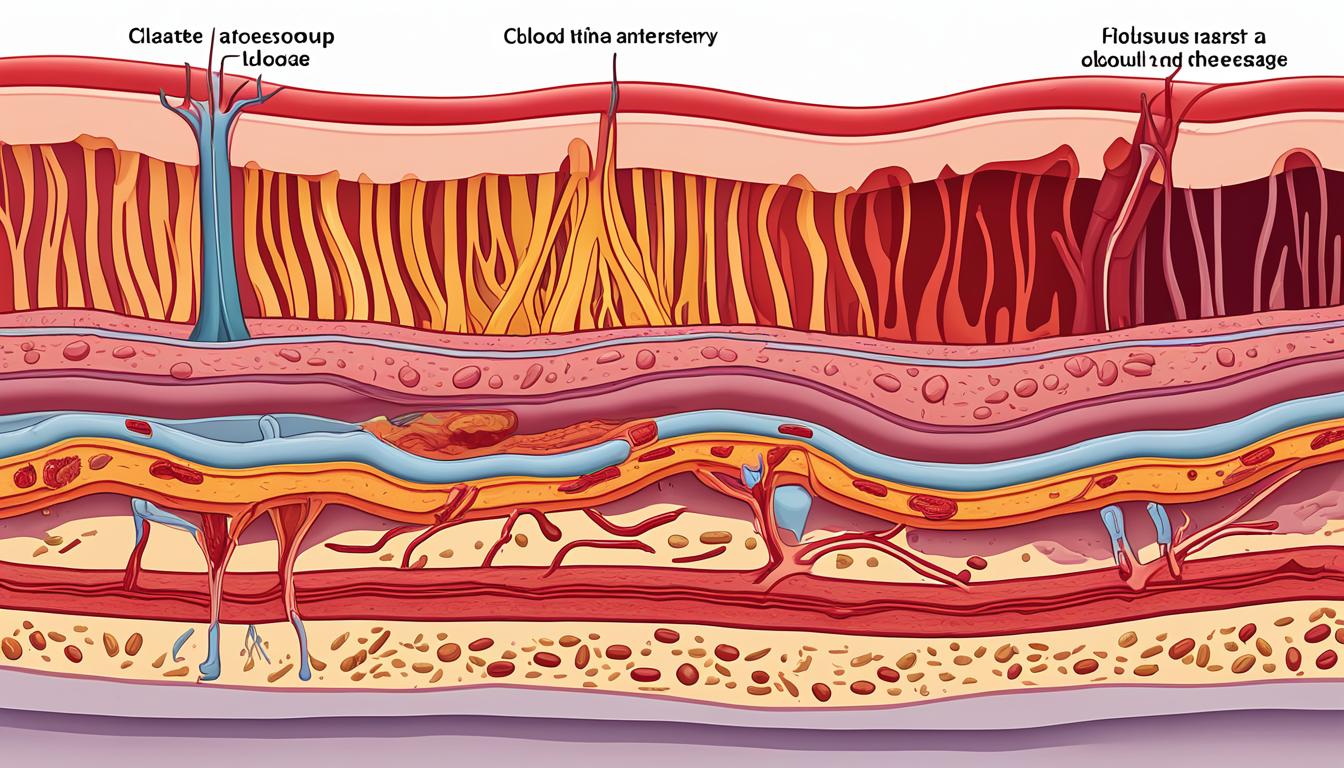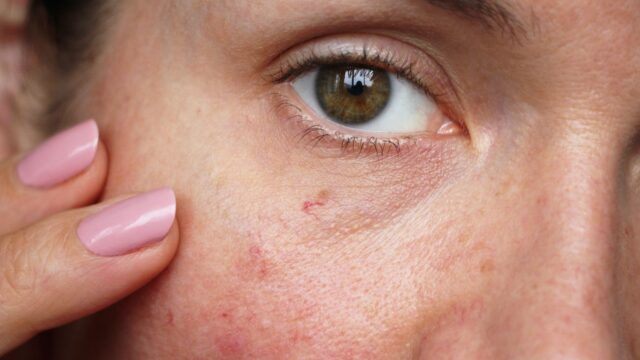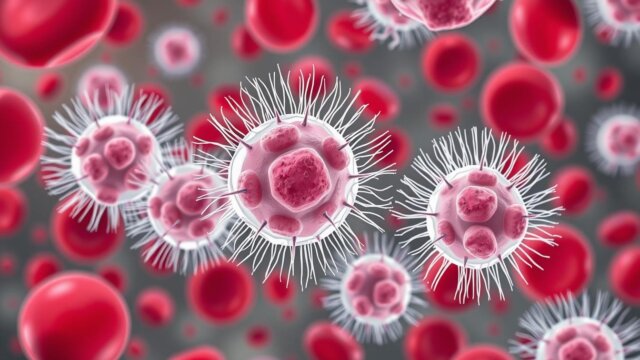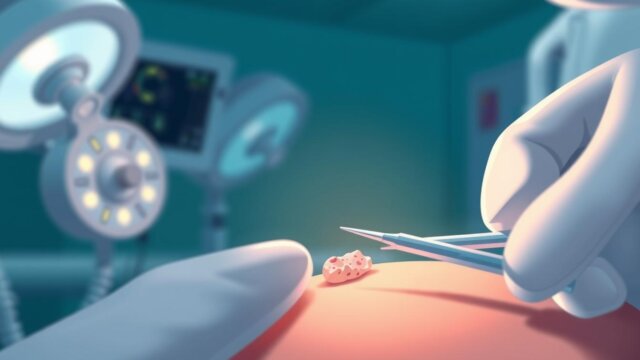FTC disclaimer: This post may contains affiliate links and we will be compensated if you click on a link and make a purchase.
By age 60, about 75% of people have some atherosclerosis. This shows how common this condition is. It’s a disease where plaque builds up in arteries. This plaque is made of cholesterol, fat, calcium, and more.
Knowing about atherosclerosis helps keep our hearts healthy. It’s key to know the causes, signs, how to diagnose it, and treatments. This knowledge helps prevent heart attacks and strokes.
Key Takeaways
- Atherosclerosis is a preventable and treatable condition, but not reversible.
- Chronic high cholesterol is the main contributing factor to atherosclerosis.
- Lifestyle changes, such as a heart-healthy diet and regular exercise, can help slow the progression of atherosclerosis.
- Medications like statins and antiplatelet drugs can manage atherosclerosis by lowering cholesterol and blood pressure.
- Surgical procedures may be necessary for severe cases of atherosclerosis.
What is Atherosclerosis?
Understanding the Buildup of Plaque
Atherosclerosis is a type of arteriosclerosis. It happens when fats, cholesterol, and other stuff build up in artery walls. This forms plaque that can narrow or block arteries.
This buildup can cause less blood flow or blood clots. It can happen in arteries all over the body, not just the heart.
Atherosclerosis is the top cause of death in the U.S.. It can happen in many arteries, like those in the heart, brain, arms, legs, pelvis, and kidneys. CAD is when plaque builds up in heart arteries. PAD is when it builds up in arteries of the legs, arms, or pelvis. Carotid artery disease is when plaque builds up in neck arteries, reducing brain blood flow.
This process often starts in childhood and gets worse with age. Plaque can start in the endothelium, the thin cell layer lining arteries. This lets “bad” (LDL) cholesterol get into the artery wall. Over time, this cholesterol and other stuff forms plaque that can block blood flow.
Atherosclerosis can lead to heart attack, stroke, vascular dementia, erectile dysfunction, or losing a limb. Finding it early and treating it is key to avoiding these serious problems.
Atherosclerosis Causes
Risk Factors for Plaque Accumulation
Atherosclerosis is when plaque builds up in your arteries over time. It’s a complex process with many factors at play. Damage to the endothelium, the inner artery lining, often starts it. This damage can come from high cholesterol, high blood pressure, inflammation, obesity, diabetes, and smoking.
When the endothelium gets damaged, it lets bad cholesterol into the artery walls. This leads to plaque buildup over time. If not treated, it can block blood flow to vital areas like the heart, brain, and legs.
Genetics and lifestyle choices can also raise your risk of atherosclerosis. Smoking is a big factor in making atherosclerosis worse in many arteries.
Plaque buildup can cause serious health issues like heart disease and stroke. If not treated, it can lead to heart attacks and other serious problems.
“Atherosclerotic cardiovascular disease (ASCVD) involves plaque buildup in artery walls and can lead to conditions like acute coronary syndrome, stable or unstable angina, stroke, transient ischemic attack (TIA), or aortic aneurysm.”
By managing risk factors like diet and exercise, you can slow down atherosclerosis and lower the risk of complications.
Early Symptoms of Atherosclerosis
Atherosclerosis, the buildup of plaque in the arteries, often doesn’t cause any noticeable atherosclerosis symptoms in its early stages. As the plaque buildup grows, symptoms may start to appear, depending on which arteries are affected.
Symptoms related to the coronary arteries, which supply blood to the heart, can include chest pain or pressure, shortness of breath, and irregular heartbeats. Symptoms related to the arteries supplying the brain can include numbness, weakness, speech difficulties, and severe headaches.
Symptoms of peripheral artery disease, which affects the arteries in the legs and arms, can include leg pain when walking (intermittent claudication) and poor wound healing. However, many individuals may not experience any symptoms until a major event, such as a heart attack or stroke, occurs.
- Atherosclerosis symptoms can start in childhood and progress more rapidly between ages 40 and 50.
- By age 60, approximately 75% of people have some degree of atherosclerosis.
- Carotid artery disease can lead to stroke when arteries become narrowed or blocked.
- Coronary artery disease, the most common form of heart disease, occurs when plaque forms in the heart’s arteries causing a heart attack.
“Atherosclerosis is silent and can start early in life, by the time symptoms occur it’s often already advanced and a serious problem.”
While the early stages of atherosclerosis may not present any clear symptoms, the condition can have severe consequences if left untreated. Recognizing the potential warning signs and taking proactive steps to manage the underlying risk factors is crucial for maintaining cardiovascular health.
Diagnosing Atherosclerosis
Finding atherosclerosis early is key to managing and preventing serious issues. The first step is often a physical exam. Your doctor will listen for strange sounds in your arteries and check for weak or missing pulses.
Your doctor might also do blood tests. These check your cholesterol, blood sugar, and inflammation markers like C-reactive protein. These tests help spot risk factors and see how atherosclerosis is progressing.
Imaging tests are also vital. They include angiograms, carotid ultrasounds, and coronary calcium scans. These tests show the plaque buildup in your arteries.
Tools like electrocardiograms (ECGs), echocardiograms, and stress tests check how atherosclerosis affects your heart. They look at heart rate, blood pressure, rhythm, or electrical activity.
By using these tests together, your doctor can fully understand your atherosclerosis. They can then make a good treatment plan.
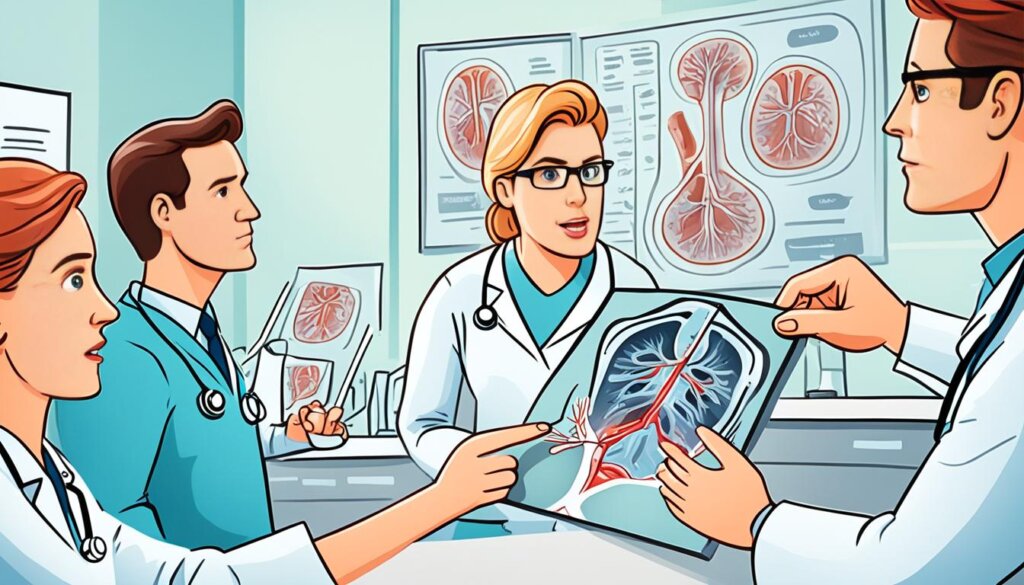
“Diagnosing atherosclerosis early is crucial for effective management and prevention of serious complications.”
Treating Atherosclerosis
Managing atherosclerosis often means making lifestyle changes and using medical treatments. Medications like statins and aspirin help by lowering cholesterol and preventing blood clots. Blood pressure-lowering drugs can also be given to lower the risk of heart attacks.
More serious steps might be needed for big blockages. Angioplasty and stent placement open blocked arteries. Bypass surgery helps by making a new path for blood. Endarterectomy removes plaque from carotid arteries. The best treatment plan depends on your risk factors, how bad the atherosclerosis is, and any heart conditions you have.
Lifestyle Changes for Atherosclerosis Treatment
Not smoking, exercising, staying at a healthy weight, and eating well can help stop or slow atherosclerosis. These changes work well with medical treatments. They help by lowering the risk factors for the disease.
Treatment Option | Description |
|---|---|
Statins | Cholesterol-lowering drugs that can slow, stop, or reverse the buildup of fatty deposits in the arteries |
Aspirin | Can help prevent blood clots and reduce the risk of complications related to atherosclerosis |
Blood Pressure Medications | Prescribed to prevent or treat complications related to atherosclerosis, such as reducing the risk of a heart attack |
Angioplasty and Stenting | Procedures to open clogged or blocked arteries and improve blood flow |
Bypass Surgery | Reroutes blood flow around a blockage in the coronary arteries |
Endarterectomy | Removes plaque from the carotid arteries to improve blood flow |
By using both medical treatments and lifestyle changes, people with atherosclerosis can manage their condition well. This can lower the risk of serious problems like heart attack and stroke.
Lifestyle Changes for Atherosclerosis
Living a healthy life is key to stopping and managing atherosclerosis. This condition happens when plaque builds up in the arteries. By changing your lifestyle, you can lower your risk of getting this condition. This can also help prevent heart disease and stroke.
Diet, Exercise, and Stress Management
Eating right is a big step towards a healthy heart. You should eat less saturated and trans fats, cholesterol, and sodium. Eat more fruits, veggies, whole grains, and lean meats.
Being active is also important. Aim for 150 minutes of moderate exercise each week. This helps keep your blood flowing well and lowers atherosclerosis risk.
Stress can also affect your health. Try relaxing, being mindful, and getting support to lower inflammation and blood pressure. This can help with atherosclerosis prevention and management.
Stopping smoking is also key. Smoking causes peripheral arterial disease, linked to atherosclerosis. Making these changes can help control atherosclerosis risk.
Lifestyle Factor | Recommendation |
|---|---|
Diet | Reduce intake of saturated and trans fats, cholesterol, and sodium. Increase consumption of fruits, vegetables, whole grains, and lean proteins. |
Exercise | Engage in at least 150 minutes of moderate aerobic exercise per week. |
Stress Management | Practice relaxation techniques, mindfulness, and seek social support. |
Smoking Cessation | Quit smoking to reduce the risk of peripheral arterial disease and other complications. |
By making these lifestyle changes, you can fight atherosclerosis. This reduces your risk of serious heart problems.

Preventing Atherosclerosis
It’s key to prevent atherosclerosis to keep your heart healthy. You can do this by managing risk factors like high cholesterol, high blood pressure, and diabetes. Eating well, staying active, keeping a healthy weight, and not smoking can help stop plaque from building up in your arteries.
Being exposed to risk factors early on can make atherosclerosis more likely later. Using statins in kids with high cholesterol can help stop atherosclerosis from starting. Keeping certain proteins at healthy levels from a young age can also prevent atherosclerosis.
Seeing your doctor regularly can spot and treat conditions that might lead to atherosclerosis. As we get older, our arteries can narrow, making them more prone to plaque buildup. High cholesterol, smoking, and not moving enough are big risks for atherosclerosis and heart problems.
By taking steps to manage heart risks and living a healthy life, you can lower your chance of getting atherosclerosis and its problems.
Risk Factor | Impact on Atherosclerosis |
|---|---|
High Cholesterol | Increases the risk of arterial narrowing and reduced blood flow to the heart. |
Smoking | A leading risk factor for atherosclerosis and heart disease. |
Physical Inactivity | Regular exercise can lower the risk of developing atherosclerosis and related heart conditions. |
Obesity | Maintaining a healthy body mass index (BMI) can reduce the risk of chronic conditions that contribute to atherosclerosis. |
Diabetes | People with diabetes develop atherosclerosis more quickly, so controlling blood sugar levels is crucial. |
“Atherosclerosis often does not present symptoms until significant damage has occurred, underscoring the importance of preventive measures regardless of symptom presence.”
Atherosclerosis and Heart Disease
Atherosclerosis is when plaque builds up in arteries. It’s the main cause of coronary artery disease, the top heart disease. This buildup can block blood flow to the heart, causing chest pain and heart attacks. About 75% of heart attacks happen because of plaque rupture, mostly in men over 45 and women over 50.
Plaque rupture can also cause a blood clot, blocking an artery and leading to a heart attack. To avoid this, it’s key to manage risk factors like high cholesterol, high blood pressure, smoking, and diabetes.
The Connection Between Plaque and Heart Attacks
Atherosclerosis is a big problem for heart health, causing heart attacks and other serious conditions. In the U.S., 18 million people over 20 have heart disease, and over 800,000 have a heart attack yearly. Smoking, high cholesterol, high blood pressure, and diabetes can damage arteries and start atherosclerosis.
Men often get atherosclerosis more than women, but after menopause, women’s risk goes up. Heart disease is the top cause of death in the U.S., killing about 650,000 people a year.
“Atherosclerosis is considered the primary cause of atherosclerotic cardiovascular diseases primarily involving the heart and brain.”
Atherosclerosis and Stroke
Atherosclerosis means plaque builds up in arteries. This can be bad for the brain. It raises the chance of stroke. Most strokes happen because of atherosclerosis. When plaque blocks arteries to the brain, it can cause a stroke by making blood clots.
Strokes are very serious. They can kill about two million brain cells every minute. Quick action is key. Medicine called tPA can help if given in the first four and a half hours. If not eligible for tPA, another treatment might work up to six hours after the stroke starts.
Knowing the signs of a stroke is important. Signs like temporary blockages can warn of a bigger stroke. Changing your life and getting medical help can lower stroke risk. New treatments like Vagus Nerve Stimulation (VNS) help stroke survivors live better lives.
Learning how atherosclerosis and stroke are linked helps us protect our hearts and brains. Fixing the root causes and getting medical help fast can save lives.
Peripheral Artery Disease and Atherosclerosis
Symptoms and Treatment Options
Atherosclerosis is when plaque builds up in arteries. It can happen in the legs, arms, and pelvis. This leads to a condition called peripheral artery disease (PAD). Over 200 million adults worldwide have PAD. It’s common in people over 70, with up to 20% affected.
Plaque makes it hard for blood to flow to the limbs. This can cause pain in the legs when walking, numbness, and slow healing of wounds. If it gets worse, PAD can cause gangrene and may need amputation.
Doctors can treat PAD with medicines, angioplasty, or bypass surgery. Making healthy lifestyle changes, like exercising and eating right, can also help. It’s important to treat atherosclerosis in the peripheral arteries to avoid serious problems.
Symptom | Incidence |
|---|---|
Leg pain during walking (intermittent claudication) | 60% of PAD patients |
No leg pain | 40% of PAD patients |
Limb amputation | Can occur if PAD is not diagnosed and treated in time |
People who smoke, have diabetes, high blood pressure, or are obese are more likely to get PAD from atherosclerosis. Many cases of PAD go unnoticed in primary care. So, knowing the symptoms and seeing a doctor is key.
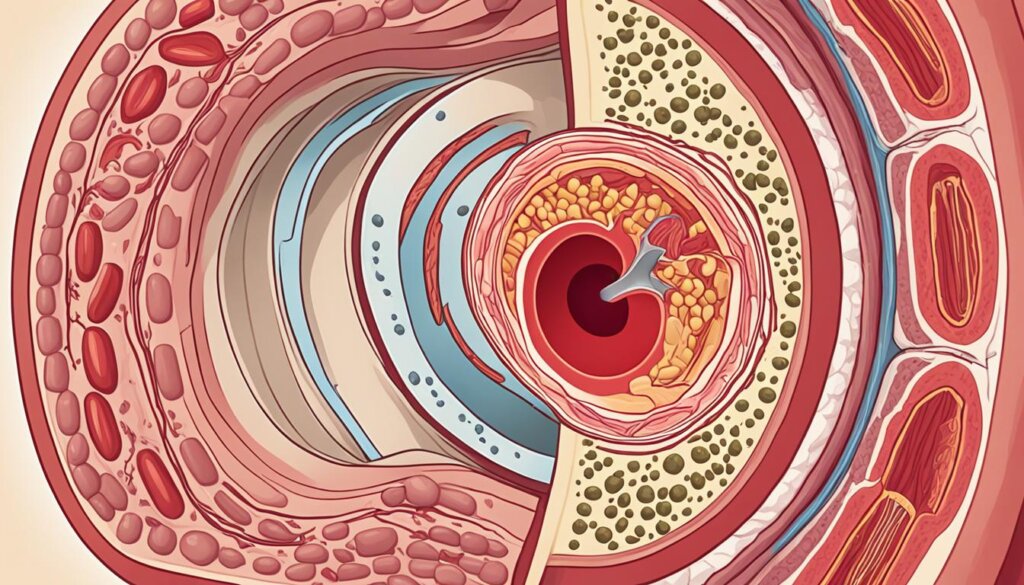
If you’re worried about PAD or have symptoms, see the Mayo Clinic for help. Catching PAD early and treating it can prevent serious issues and improve your life.
Atherosclerosis Complications
Atherosclerosis is when plaque builds up in your arteries. If not treated, it can lead to serious problems. It can happen in many arteries, like those that feed your heart, neck, and limbs. This starts early, often in childhood, and gets worse as you get older.
A heart attack is a big risk from atherosclerosis. Plaque in the coronary arteries can block blood to the heart, harming the muscle. Strokes are also a big worry. They happen when plaque blocks arteries to the brain, causing brain damage. Poor blood flow in your limbs, known as peripheral artery disease, can be severe and might need amputation.
Aneurysms are another issue with atherosclerosis. These are weak spots in big arteries that can burst, causing serious bleeding. Atherosclerosis can also hurt your kidneys by reducing blood flow to them.
Not managing atherosclerosis can lead to big problems. You need to make lifestyle changes, take medicine, and sometimes surgery to stop these issues. By dealing with the causes of atherosclerosis, you can lower your risk and keep your heart healthy.
“Atherosclerosis is a leading cause of death and disability worldwide, and its complications can be devastating if left unchecked. Proactive management is key to preventing these issues and maintaining a healthy cardiovascular system.”
Atherosclerosis Progression
Atherosclerosis starts with a fatty streak on artery walls, even in childhood. This fatty streak can turn into a fibrous plaque over time. This plaque makes the blood vessel bigger and causes a bump. Later, the plaque can break apart, showing the cholesterol and tissue under it. This can cause an immune reaction and blood clots, blocking blood flow.
The Stages of Plaque Buildup
Atherosclerosis happens step by step, with different stages of plaque buildup. Studies in 2017-2018 showed how atherosclerosis gets worse. First, a fatty streak forms with cholesterol and other stuff in the artery wall. Then, this fatty streak can turn into a fibrous plaque, which is a serious problem. Finally, the plaque can break apart, causing more issues like blood clots.
Knowing the stages of atherosclerosis helps doctors treat it better. Tests like blood tests and ultrasounds help find out how bad it is. This way, doctors can make a plan just for you.
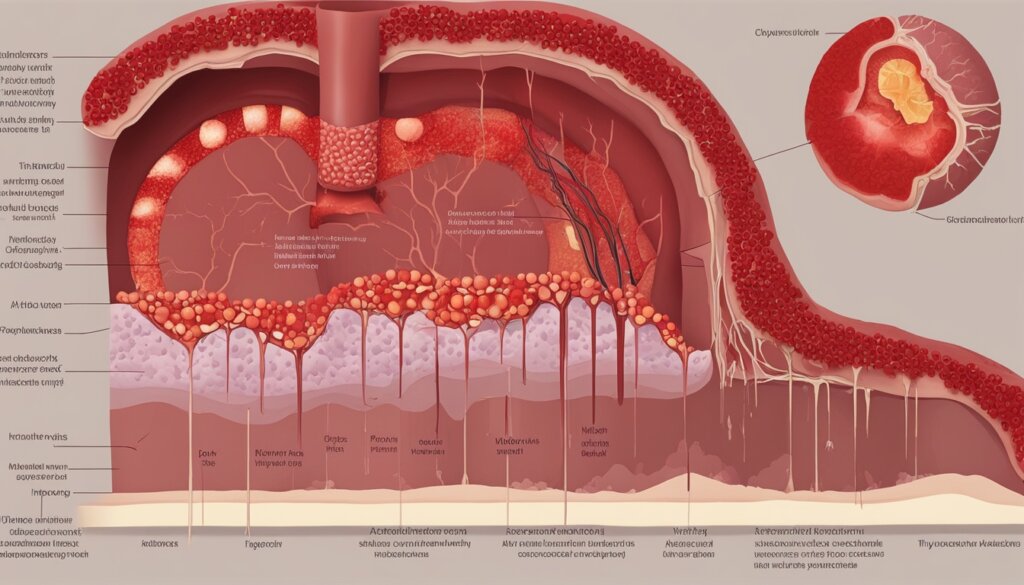
Understanding atherosclerosis helps people take care of their heart health. This can lower the risk of heart attack and stroke.
Stage | Description |
|---|---|
Fatty Streak | Accumulation of cholesterol and other substances in the artery wall |
Fibrous Plaque | More advanced and dangerous form of atherosclerosis, where the fatty streak develops into a plaque |
Complicated Lesion | The plaque begins to break up, exposing the cholesterol and tissue beneath it, triggering an immune response and the formation of blood clots |
“Understanding the stages of atherosclerosis is crucial for monitoring the condition and implementing appropriate interventions to slow its progression.”
Alternative Therapies for Atherosclerosis
Traditional medicine is key for treating atherosclerosis. Yet, some alternative therapies and supplements might help too. Alpha-linolenic acid, barley, beta-sitosterol, cocoa, fish oil, garlic, and green tea are natural options studied for lowering cholesterol and inflammation.
A 2021 study showed a Mediterranean diet with extra virgin olive oil slowed down atherosclerosis better than a low-fat diet. Omega-3 from fish oil might also make atherosclerosis plaques more stable, lowering the risk of rupture. Plus, regular exercise can protect arteries by releasing adrenaline, which fights inflammation.
These natural methods look promising but aren’t as proven as traditional treatments. Always talk to a doctor before trying supplements or new therapies for atherosclerosis. Combining these with proven medical care is best for prevention and treatment.
Therapeutic Approach | Potential Benefits |
|---|---|
Mediterranean Diet | Decreased atherosclerosis progression |
Stabilize vulnerable atherosclerosis plaques | |
Regular Moderate Exercise | Protective effect on the arteries, anti-inflammatory |
No single natural remedy can clear artery plaque. Eating well, exercising, managing stress, and quitting smoking can slow atherosclerosis. But, some might need medicines like ACE inhibitors or statins. Always talk to a doctor to find the right treatment.
“Integrating evidence-based lifestyle changes and conventional medical care remains the foundation for preventing and treating atherosclerosis.”
Atherosclerosis Research and Advancements
The study of atherosclerosis is always moving forward, bringing new ways to prevent, find early, and treat this common heart condition. Scientists are looking at many new ideas. These include new medicines, surgery, changing lifestyles, and gene therapies.
Recently, researchers at the University of Texas Southwestern Medical Center found something big. They turned off a certain enzyme in mice with atherosclerosis and saw a 55% drop in plaque buildup. They also found that giving these mice more of a certain substance made things worse. But, stopping a certain cell type from reacting a certain way stopped the disease from getting worse.
This study had a team of experts, including Dr. Chieko Mineo and Dr. Lin Xu. It was backed by the NIH, American Heart Association, and Rally Foundation.
The National Heart, Lung, and Blood Institute has been leading atherosclerosis research for years. They’ve looked into inflammation, diabetes and atherosclerosis, and genetic studies on plaque buildup. Their work has led to new medicines that lower cholesterol and heart risks.
They’re now funding projects on gene therapy and new imaging methods to study atherosclerosis. They’re also looking into how sleep apnea affects heart health. They want to see if treating sleep issues can stop plaque from forming.
Other studies are exploring how stress, stem cells, and genes affect atherosclerosis. With all these new findings and trials, we’re getting closer to better ways to prevent and treat this disease.
“The research landscape is further enhanced by numerous other studies, including investigations into the role of oxidative stress, stem cell transcription factors, and genetic influences on atherosclerosis progression.”
Conclusion
Atherosclerosis is a complex condition that can harm your heart health. Studies show it’s the top cause of death and disability in many countries. It’s getting more common in other countries too. Knowing the risks, like high LDL cholesterol and lifestyle choices, helps prevent it.
There’s no cure for atherosclerosis, but you can slow it down. This can help avoid serious health issues like heart attacks and strokes. New research and treatments are making things better for people with atherosclerosis. Working with doctors and changing your lifestyle can help you manage it better.
Looking after your heart health is key to a good life. With the right medical care, lifestyle changes, and new research, you can lessen the risks of atherosclerosis.
FAQ
What is atherosclerosis?
Atherosclerosis is when arteries get hard because of plaque buildup. This plaque is made of cholesterol, fat, and other stuff. It can block blood flow and raise the risk of heart attacks and strokes.
What causes atherosclerosis?
We don’t know all the reasons why atherosclerosis happens. But it often starts with damage to the artery walls. This can be from high cholesterol, high blood pressure, inflammation, being overweight, having diabetes, or smoking.
What are the early symptoms of atherosclerosis?
In the early stages, atherosclerosis doesn’t show symptoms. Later, you might feel chest pain or pressure, have trouble breathing, feel numb or weak, have trouble speaking, or find it hard for wounds to heal.
How is atherosclerosis diagnosed?
Doctors start by doing a physical exam and blood tests. Then, they might use imaging tests like angiograms and ultrasounds. Other tests like electrocardiograms and stress tests might be needed too.
How is atherosclerosis treated?
Treating atherosclerosis often means making lifestyle changes and using medicines. Doctors might prescribe statins and aspirin. Sometimes, more serious treatments like angioplasty, stent placement, bypass surgery, and endarterectomy are needed.
What lifestyle changes can help prevent and manage atherosclerosis?
To prevent and manage atherosclerosis, you should eat a diet low in bad fats and sodium. Stay active, manage stress, and quit smoking.
How does atherosclerosis lead to heart disease and stroke?
Atherosclerosis is the main cause of coronary artery disease, which is a common heart disease. It can also affect arteries going to the brain, raising the risk of stroke.
What are the potential complications of unmanaged atherosclerosis?
If atherosclerosis is not treated, it can lead to serious problems. These include heart attacks, strokes, peripheral artery disease, aneurysms, and chronic kidney disease.
How does atherosclerosis progress over time?
Atherosclerosis starts with a fatty streak on artery walls, which can start early. Over time, it can turn into more serious plaque and lesions.
Can alternative therapies help manage atherosclerosis?
Some alternative treatments and supplements might help with atherosclerosis. These include things like alpha-linolenic acid, barley, and fish oil. But, it’s best to talk to a doctor before trying them.
What advancements are being made in the field of atherosclerosis research?
Researchers are working on new ways to prevent, detect, and treat atherosclerosis. They’re looking at new medicines, surgical methods, and lifestyle changes to slow down plaque buildup and lower heart disease risk.
